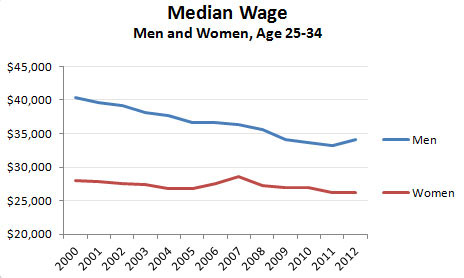Bloomberg has a long article today wondering whether wage stagnation is mainly due to demographic shifts:
25- to 34-year-olds will make up 22.5 percent of the workforce by 2022, compared with 21.6 percent in 2012….Meanwhile, the share of 45- to 54-year-olds in their best earning years will drop by 3.3 percentage points in the decade ending 2022.
….Hollowing out the middle-aged working population could cut median earnings because such employees bring home the biggest paychecks. The median 45- to 54-year-old household earns $66,400 a year, compared with $51,400 for 25- to 34-year-old households.
Well, sure. Compared to 30 years ago, the theory goes, we have more young workers bringing down the average and fewer prime age workers raising the average. As a result, the average is declining. But all that means is that  baby boomers are aging out of the workforce, not that wages are necessarily in bad shape.
baby boomers are aging out of the workforce, not that wages are necessarily in bad shape.
That makes sense. At least, it would make sense if it were true. The thing is, in an article more than a thousand words long, we never learn that we can look at this directly. The chart on the right shows the median wages of just 25-34 year olds, and as you can see, they’ve been declining for more than a decade. This has nothing to do with demographics because it’s measuring wages for the same age group the entire time.
Now, these figures don’t include health insurance, and they only go through 2012. So they aren’t of much help if, say, the Fed is trying to gauge the tightness of the labor market in the second quarter of 2014. Nonetheless, they certainly show a long-term trend of wage stagnation that plainly has nothing to do with demographics. This makes it vanishingly unlikely that wage stagnation over the past six months is merely due to demographic shifts.
It’s a nice fairy tale to pretend that wage stagnation might just be an artifact of boomers retiring, but easily available data quite clearly shows otherwise. It’s real.













